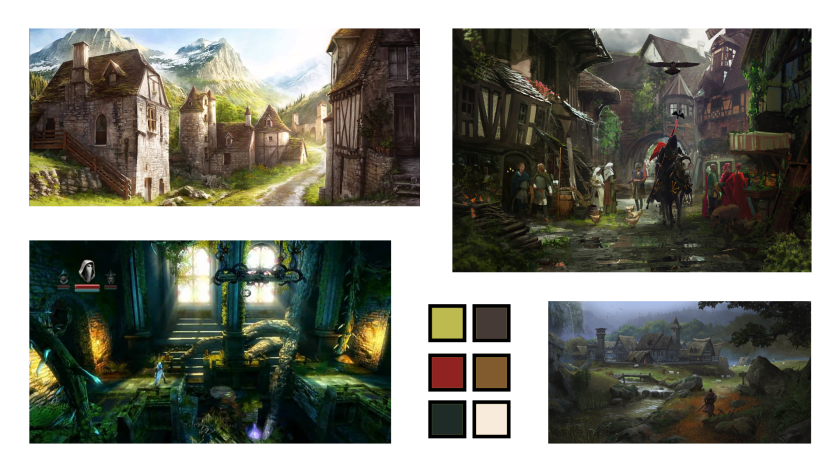This week we decided that we would be further developing our ‘Stolen Artefact’ game idea and thus began the process of envisioning the style we wanted to aim for. We’ve decided to go with a realistic, medieval and fantasy type of ‘look and feel’. The following article ‘https://www.quora.com/Why-are-so-many-epic-fantasies-set-in-a-medieval-setting‘, explores how medieval and fantasy go so well together and why this mix of themes has resulted in so many ‘epic’ games over the years. A lot of credit can be given to J.R.R Tolkein’s ‘Lord of the Rings’, and to share such a theme with a the incredible world Tolkein created means that we must be doing something right! The following mood-board depicts this theme that we want and certain references that we have taken inspiration from. A colour palette has also been included of our focus colours, pulled from these reference images.

Image Sources (Left to right, top to bottom)
- Oak’s Crossing
- Medieval Town
- Trine Gameplay
- European Medieval Village
We took our inspiration from the images in the above mood board and games such as WarCraft III, The Elder Scrolls Online, Trine 2 and Kingdom Come Deliverance. The fundamental shape structures of our game are squares, triangles, and sharp angles. We want to the environment to be defined in a strong way and to assert a certain dominance over the player. We’re staying from circles and round objects/structures as we want to stay away from any cute or peaceful ideas. These strong, straight shapes promote aggression which suits our overall revenge theme, we want players to be invested into the story through the environment as well.
A game’s ‘look and feel’ is absolutely crucial in conveying the game’s overarching theme to a player. In the linked article, Viktor Antonov, the art director behind Bethesda’s successful new 2012 IP, Dishonored, describes how the art of Dishonored helps shape the feel of the game and support the story (http://www.gameinformer.com/b/features/archive/2011/07/20/the-look-and-feel-of-dishonored.aspx).
We believe that through the use of such shape structures and by sticking to the style and colouring of the above mood board, our target audience, Bob, will be able to accurately interpret the ‘look and feel’ we are going for in our games. As a player of similar medieval fantasy games, such as WarCraft and even darker games such as Doom, which suit our revenge theme, Bob will easily recognise the style of game and be drawn into it. We believe Bob will respond positively to our aggressive styling and feel more invested in the story because of it’s supporting environment.
Our game requires ‘2.5’ dimensions, in that it’s a fundamentally 2 dimensional game (left, right, up, down) that is played within a 3 dimensional world. So the third dimension, or in this case the half dimension, can be seen as part of the environment but cannot be interacted with or accessed. The world will be bound to the constraints of the levels themselves, be that the city wall in a city level, the inside of a building, or two destinations on the countryside.
The game is set in Medieval Europe, a period which spans between the 5th and 15th Centuries and will be realistic with the exception of ‘realistic’ fantasy elements such as magic. Levels will take place both indoors and outdoors with settings such as villages, castles and rolling countrysides. Game world objects will be realistic as will the NPCs inhabiting the world, which take the form of ordinary humans, no other races are present.
Sounds present in the game will reflect the mood and setting, with ‘medieval sounds’ such as from the following;
being used to create atmosphere. Recorded sounds from reenacted battles or period-correct equipment could also be used to boost realism.
Vincent Bornaghi, N9463020
